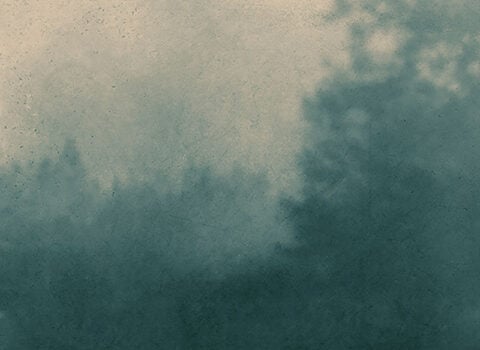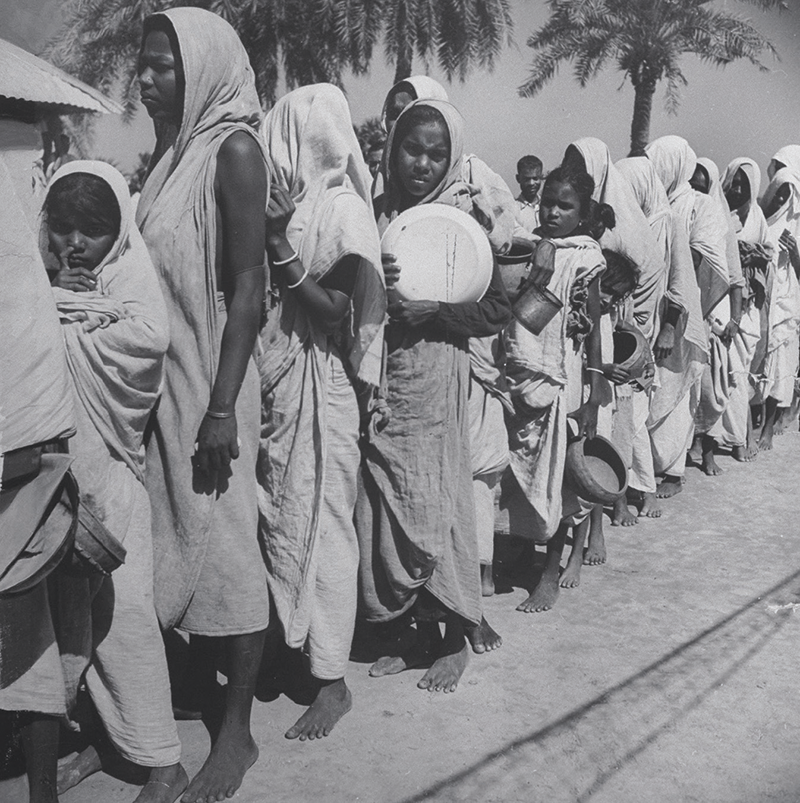
Women in Calcutta waiting in line for food during the Bengal famine of 1943 © William Vandivert/The LIFE Picture Collection/Shutterstock
As the economist and philosopher Amartya Sen approaches ninety, he has written a moving and urgent memoir, Home in the World (Liveright, $30), in which he lays out the early influences on his life and work, particularly his groundbreaking studies about famine, welfare economics, and social-choice theory, for which he won the Nobel Memorial Prize in Economic Sciences in 1998.
From the first, Sen was marked for great things: his maternal grandfather, the renowned Sanskrit scholar Kshiti Mohan Sen, was a close friend and collaborator of the poet and writer Rabindranath Tagore, who named the infant Amartya—“immortal” in Sanskrit. The child of a chemistry professor and an accomplished dancer in Tagore’s dramas, Sen also attended the late Tagore’s progressive school in Santiniketan, West Bengal, where, among other things, women were taught judo.
Though Sen was a prodigious mathematician in boyhood, an early love of the Bengali waterways led him to an interest in their economic importance, and to Adam Smith’s analyses of the role rivers and canals played in developing the market economy. Similarly, witnessing the Bengal famine of 1943 when he was just nine years old shaped Sen’s enduring commitment to fighting inequality, and would lead him to vital work such as his landmark 1981 book Poverty and Famines, in which he argued, through a series of case studies, that famine is caused not merely from a lack of food, but from a failure to equitably distribute existing supplies. The handling of the famine—the way journalists were muzzled until the British editor of the Calcutta newspaper the Statesman rebelled—taught Sen the importance of a free and honest press. Sen’s atheism also came to him in youth; he records both his wonderment and frustration at discovering that his supposedly irreligious perspective had already been articulated by Madhavacharya in the fourteenth-century Sanskrit text the Sarvadarsana Samgraha (“Collection of All Philosophies”). In presenting him with a copy, his grandfather assured him: “You have placed yourself, I can see, in the atheistic—the Lokayata—part of the Hindu spectrum!”
Sen’s family, education, and environment impressed on him the importance of religious and cultural plurality, discussion and debate, and a humanist, cooperative, anti-identitarian approach. His relatives included activists who were repeatedly jailed in the struggle for Indian independence; his liberal family strongly opposed partition, believing instead in a religiously and culturally diverse India. In a chapter on his native Bengal, Sen makes the case that its history is “a tale of integration, rather than one of religious partition and cultural disintegration,” and that this integration “makes a united and secular Bangladesh a feasible and elevating idea, and allows it to face the world on its own terms.”
In 1951, Sen went to study at Presidency College in Calcutta, where he focused on economics, in part at a friend’s urging, but also with the recognition that it would assist with his “idea of working for a different kind of India—one not as poor, nor as iniquitous and not at all as unjust.” It is in this context that Marx enters Sen’s book, as the central and guiding influence in left-wing economic thought at the time. With Marx, as with everything, Sen encourages a nuanced view. He argues that Marx has been decontextualized and reductively read. Marx’s 1875 position that “being a worker cannot be the sole identity of any person,” Sen contends, is vital in understanding today’s “identity-based conflicts.”
Sen’s work as an economist and philosopher spans continents—his career took him from Trinity College, Cambridge, where he would later become Master, to MIT, Stanford, and Harvard—and incorporates diverse influences. He generously includes the names of many of his friends and collaborators, and at moments, particularly in its latter half, the memoir has the quality of a biblical list. But even this act of almost relentless inclusion seems an indication of Sen’s gracious but passionate insistence on complexity and connectedness, and on the need for human cooperation.
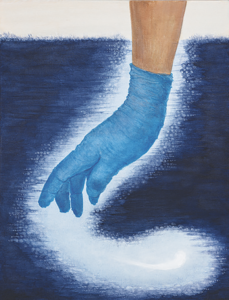
May 2020, by N. S. Harsha © The artist. Courtesy Victoria Miro, London
The protagonist of Weike Wang’s second novel, Joan Is Okay (Random House, $27), insists on very little. An unmarried thirty-six-year-old ICU doctor, Joan lives alone, is friendly with her immediate colleagues but otherwise largely without social contacts, and waxes enthusiastic about the robot vacuum in her apartment and the ECMO machine (“extracorporeal membrane oxygenation”) in her medical unit, which “rarely needed maintenance, while in every public bathroom everywhere, half the automatic faucets didn’t run and the only paper towel dispenser didn’t dispense.”
At the novel’s outset, Joan (whose Chinese name is Jiu-an) has just returned from a weekend in China for her father’s funeral, having left immediately so as not to miss multiple shifts at work. She was born and raised in the United States, but at eighteen, she says, “I was dropped off at Harvard, and within a few months my parents had sold most of their things and left the country.” In contrast, her older brother Fang spent his childhood years in China with relatives, separated from the family until he joined them in Wichita, Kansas, at the age of twelve—the first time he and Joan met. Now a wealthy businessman, he resides in a mansion in Greenwich, Connecticut, with his Chinese-born wife, Tami, and their three young sons; it is here that the siblings’ widowed mother comes to stay for what is supposed to be a few months.
In Joan, Wang has created a compelling character, utterly distinct, and the novel is carried by her dispassionate, clear-eyed, and often drily amusing narration. We come to understand her grief not through her own words, but through the quiet maneuvers she employs to sidestep emotion. She takes on many extra shifts at work, to the point where she outshines her colleagues. She avoids the concern of others, from the kindly doorman in her building to her aggressively friendly new neighbor Mark, who plies her with books, television recommendations (Seinfeld, Friends), and even furniture and appliances. Most poignantly, after visiting her mother at Fang’s house, Joan has an oblique exchange with her cab driver. He understands that she is mourning and pulls the cab onto the shoulder: “Twenty minutes later I said he could take me to the station.”
Set in 2019 and 2020, Joan Is Okay is, of course, a pandemic novel: Joan’s mother will not be able to return to Shanghai in February as planned—or in June, or in August, for that matter. And Joan, after an imposed bereavement leave that forces her to spend time with her family, returns to the hospital as the number of COVID-19 cases rises.
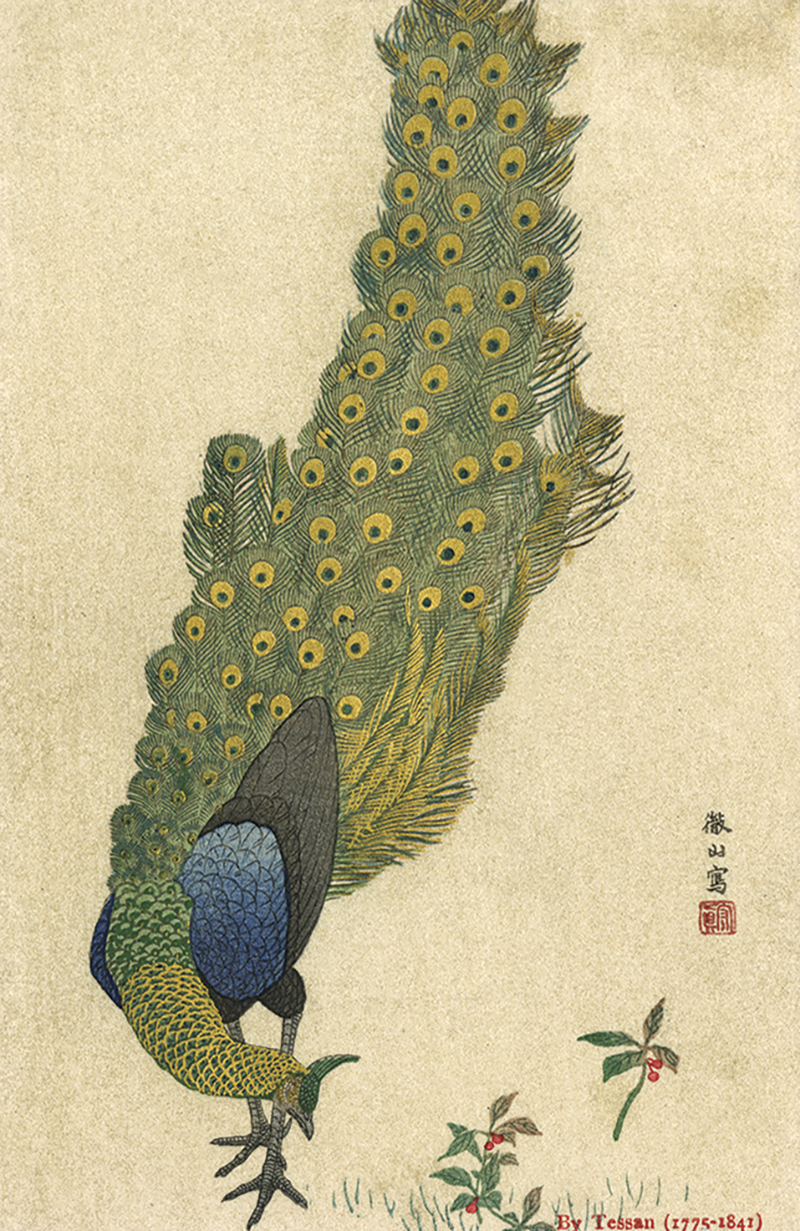
A peacock, by Mori Tessan © Mary Evans Picture Library
But the pandemic—that inescapable memento mori—serves as a frame and a catalyst rather than a subject. On account of a particular concatenation of events, Joan is forced to face long-deflected emotional questions. What does family mean for one like hers, that has, in effect, been amputated? “Limbs feel hacked off, and you find yourself hobbling around on one leg.” And then, where is home? Joan tells her director at the hospital that the first time she put on her white coat, “it felt like home.” She continues, explaining: “I didn’t prioritize home or comfort, because if everyone did, then immigrants like my parents, brother, and sister-in-law couldn’t exist.”
Such powerful insights will resonate with many, especially those with histories of displacement; and in Joan’s case, they prove sufficiently unsettling to disrupt the balance of her carefully controlled life. This aspect of the narrative feels utterly true. At the same time, Wang occasionally deploys an ironic, almost satirical hyperbole that is engaging and funny, but can shift the novel’s register closer to moralistic fable. For example, Fang and Tami, in the comfort of their enormous Greenwich estate, organize seasonal parties, such as their annual Harvest Bash, the invitation for which Joan receives in a wicker basket bursting with an assortment of lavish treats (“one pound of Royal Riviera pears, two pounds of seasonal apples,” and so on). The day’s activities would include:
an on-site horse-drawn hayride, a petting zoo (goats, peacocks, and mini horses), face painting (back by popular demand), and make your own cornucopias. Come taste our handcrafted seasonally spiced cocktails, the invite said. RSVP required two weeks in advance.
Mark, whose behaviors constitute an important thread, acts with analogous—or even greater—comic extravagance, which culminates in a surprise party that he organizes for Joan in her own apartment, a radical intrusion closer to something from an episode of Friends or Seinfeld than to actual, recognizable experience. This disjunction between the agonizing realism of Joan’s perspective and the cartoonish antics around her serves the novel in certain ways (enabling greater levity in an often dark account) but ultimately muffles the narrative’s consequence.
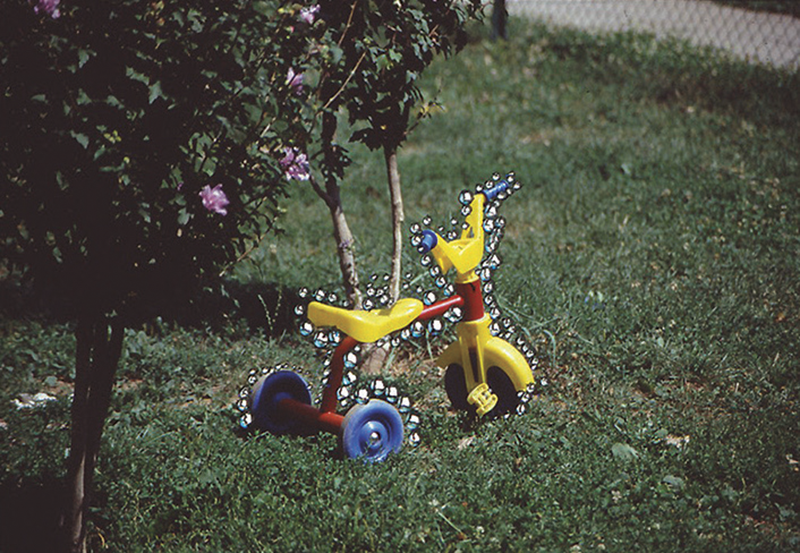
Triciclo giallo, by Stefano Arienti © The artist. Courtesy Studio Guenzani, Milan
The Norwegian writer Gunnhild Øyehaug also plays with realism in her new novel Present Tense Machine (Farrar, Straus and Giroux, $25), and with considerably greater flamboyance. Øyehaug, a postmodernist with Borgesian echoes, frequently uses surrealist and metafictional elements in her work. In this instance, the plot follows a mother and daughter, Anna and Laura, whose lives have been bifurcated into alternate realities. One day in 1998, Anna reads a poem by the Finnish-Swedish writer Tua Forsström as Laura, then two and a half, plays nearby on her tricycle. Anna mistakes the word “trädgård” (“garden” in Swedish) for the nonsense word “tärdgård,” the latter “a potential word, a word that might have existed if only someone had thought of it”—and is propelled into an alternate reality in which, while still living in the same home and still married to her husband Bård, she has no recollection of having had a child. In this world, Laura ceases to exist. At the same time, on a parallel track, Bård comes home to find little Laura playing alone in the garden, the very idea of his wife having vanished, leaving him to wonder, “Who is Laura’s mother? Who is the female link? Her origins, her mother?”
The novel, in an elegant translation by Kari Dickson, follows these two women through a season twenty-one years later, in 2019, when Laura is twenty-four, heavily pregnant, and living with her rock-star partner, Karl Peter Voll. Anna, who long ago remarried and had two children, writes poetry and fiction under a pseudonym, and considers applying to participate in a performance of Erik Satie’s “Vexations,” in which a half page of music is to be replayed 840 times in relay for approximately twenty-five hours. Laura, too, will play in this concert, after she has gone to visit (with the intent of purchasing) the very flat in which, in her original, unbifurcated reality, she was Anna’s child. From the piano in this apartment, she steals the sheet music of the same Satie piece.
This circling game becomes more and more elaborate as we learn that Anna, whose pseudonym is Hedda Solhaug (“a combination, as we no doubt are all aware, of Ibsen’s plays Hedda Gabler and The Feast at Solhaug”), and whose author biography consists only of the line “Hedda Solhaug is a text machine,” is attempting to write a novel about language.“Is there any point? Will it be possible for her to mine the essence of language? If no one else has managed, why should she?”
Sitting with her family at dusk during Earth Hour, March 30, 2019, when everyone is asked to refrain from using electricity, Anna is struck by the fact that historically, “when the dark comes creeping, or falling, and all we can see is each other’s faces around the fire, that is what we do: we tell stories.” Whereas in the present, as her husband and children sit, each alone on their cell phones, Anna reflects that “the modern archetypal epic situation, on the other hand, appears to have a cold, blue light”—this, when the Earth Hour might be a time to remember our mortality. “That we will disappear. That we come from the great darkness. That our lives here on earth in the light are framed by absolute pitch-black.”
Anna can neither accept nor transcend mortality; or perhaps her acceptance of it might allow for transcendence. “She can’t write a novel about language. It conflicts with the spirit of the time. She, as a person, conflicts with the spirit of the time,” Øyehaug writes. “She should write a novel about microplastics. Or she should die, so that her work will be read with a greater distance.” But the novel she’s trying to write isn’t only about language. It’s also, if you will, about microplastics, about an old woman who, after a great nuclear war between East and West, lives in a hovel, “where she sits and writes a story that no one will read, yet she persists in writing.” This Beckettian “I can’t go on, I’ll go on” expresses the absurdity of the writer’s undertaking in the Anthropocene, and by extension, the absurdity of Present Tense Machine itself.
Øyehaug is splendidly clever, perhaps too clever for some. But she’s also thoughtful, using her elaborately conceived, interconnected narrative spirals to ask questions about the relevance and importance of stories, and about connections between the literarily lived life and the literally lived life. Simultaneously, she inquires about and, in spite of everything, enacts the divine power of language to create.



